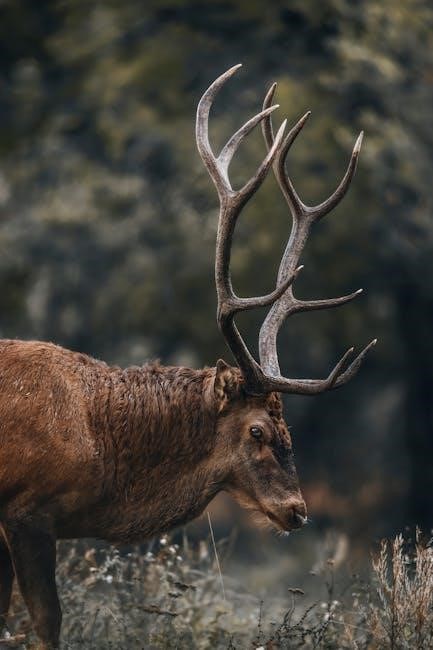Kentucky elk guides are experienced professionals offering expertise for successful and safe elk hunting adventures. Their local knowledge enhances hunters’ experiences, providing valuable insights into elk behavior and habitats, leading to higher success rates and supporting conservation efforts through ecotourism.
The Importance of Professional Guidance in Elk Hunting
Professional guidance is essential for a successful and safe elk hunting experience in Kentucky. Elk hunting in the state’s vast, remote areas can be challenging due to dense forests and rugged terrain. Guides possess extensive local knowledge, enabling them to track elk effectively and navigate difficult landscapes. Their expertise in elk behavior, migration patterns, and habitat ensures hunters are positioned for optimal success. Additionally, guides provide critical support with logistics, such as gear transportation and field preparation, while ensuring compliance with Kentucky’s hunting regulations. Their presence enhances safety, reduces risks, and maximizes the chances of a rewarding and memorable hunt.
Overview of Kentucky’s Elk Population and Hunting Opportunities
Kentucky’s elk population has grown significantly since their reintroduction in the 1990s, with over 1,500 elk brought to the state. Today, the population is thriving, offering hunters exciting opportunities in the Appalachian region. The state’s elk hunting season typically runs from September to December, with options for archery and firearms. Hunters are drawn to Kentucky’s rugged terrain, which features dense forests and open meadows, creating a challenging yet rewarding environment. The elk population is well-established, and the state’s conservation efforts have ensured sustainable hunting practices. This combination of abundant wildlife and diverse landscapes makes Kentucky a popular destination for elk hunters seeking a unique and memorable experience.
History of Elk in Kentucky
Elk once thrived in Kentucky, but by the mid-1800s, overhunting and habitat loss led to their near-extinction, leaving the state without elk for over a century.
The Restoration of Elk in Kentucky
The restoration of elk in Kentucky began in the 1990s through a collaborative effort between state wildlife agencies and conservation organizations. Over 1,500 elk were reintroduced from western states to reestablish a sustainable population. This initiative aimed to restore a species that had been absent for over a century due to habitat loss and overhunting. The program was highly successful, with elk thriving in the state’s suitable habitats. Today, Kentucky boasts a healthy and growing elk population, offering opportunities for hunting and wildlife viewing. This restoration not only benefits biodiversity but also supports local economies through ecotourism and hunting guide services.
Historical Significance of Elk in the Region
Elk once thrived in Kentucky, playing a vital role in the region’s ecosystems and human history. Native American tribes relied on elk for food, tools, and clothing, while early European settlers hunted them for sustenance. By the mid-19th century, elk were nearly extinct in Kentucky due to overhunting and habitat loss. Their historical presence is a testament to the state’s rich biodiversity. The absence of elk for over a century left a void in the ecosystem, highlighting their importance as a keystone species. Today, their reintroduction has revitalized the region’s wildlife heritage, connecting modern hunters and conservationists to Kentucky’s natural history.
Role of Kentucky Elk Guides
Kentucky elk guides provide expertise, local knowledge, and logistical support, enhancing hunters’ success and safety. Their insights into elk behavior and habitats ensure a productive and memorable hunting experience.
Expertise and Local Knowledge of Guides

Kentucky elk guides bring decades of experience, offering unparalleled insights into elk behavior, habitats, and migration patterns. Their deep understanding of the region’s terrain, from dense forests to open meadows, ensures hunters are positioned in prime locations. Guides are well-versed in tracking and stalking techniques, allowing them to predict elk movements accurately. This expertise, combined with local knowledge of seasonal changes and weather impacts, maximizes hunting success. Their familiarity with Kentucky’s diverse ecosystems enables effective navigation, ensuring a seamless and strategic hunting experience. By leveraging their extensive background, guides provide hunters with a unique advantage, enhancing both safety and the likelihood of a successful harvest.
How Guides Enhance Hunting Success Rates
Kentucky elk guides significantly improve hunting success by leveraging their extensive local knowledge and expertise. They identify prime locations, predict elk movements, and employ effective tracking and stalking strategies. Guides understand seasonal patterns, weather impacts, and elk behavior, enabling hunters to be in the right place at the right time. Their ability to interpret signs and anticipate elk reactions enhances the likelihood of a successful encounter. Additionally, guides handle logistics, allowing hunters to focus solely on the hunt. Their strategic planning and hands-on support ensure a higher probability of harvesting an elk, making guided hunts far more productive than solo efforts.
Logistics and Support Provided by Guides
Kentucky elk guides offer comprehensive logistical support, ensuring a seamless hunting experience. They handle transportation, gear management, and camp setup, allowing hunters to focus on the hunt. Guides provide field dressing and meat handling services, ensuring proper care of harvested elk. They also manage accommodations, meals, and equipment, reducing the burden on hunters. Their knowledge of terrain and weather conditions helps navigate challenging landscapes safely. Additionally, guides often assist with licensing and permit requirements, ensuring compliance with regulations. This full-service approach enhances the overall hunting experience, making it more enjoyable and stress-free for hunters of all skill levels.
Preparation for an Elk Hunt
Preparation is key to a successful elk hunt, involving physical conditioning, essential gear, and mental strategies. Guides often provide tailored advice to ensure hunters are fully ready for the challenge.
Physical Conditioning for the Hunt
Physical conditioning is essential for elk hunting in Kentucky, as it demands endurance and strength to navigate rugged terrain. Hunters should engage in cardio exercises like running or cycling to build stamina. Strength training, such as squats and lunges, prepares muscles for carrying gear and hiking long distances. Proper footwear and clothing are vital to avoid fatigue and injuries. Practicing uphill walks with a loaded backpack simulates hunting conditions. Starting a conditioning routine months in advance ensures readiness for the physical demands of the hunt. Guides often emphasize the importance of being physically prepared to maximize success and safety in the field.

Essential Gear for a Successful Hunt
Essential gear for a successful elk hunt in Kentucky includes a reliable rifle or bow with a high-quality scope for accuracy. Camouflage clothing and scent-control gear help avoid detection, while sturdy backpacks and waterproof boots are crucial for navigating rugged terrain. Binoculars and rangefinders aid in spotting and tracking elk effectively. A first-aid kit, GPS device, and emergency shelter are vital for safety in remote areas. Guides often recommend specific gear based on the season and hunting conditions, ensuring hunters are well-prepared for the challenges of elk hunting in Kentucky’s diverse landscapes. Proper equipment enhances both safety and success in the field.
Mental Strategies for Hunters
Mental strategies are crucial for a successful elk hunt in Kentucky. Hunters must cultivate patience, focus, and resilience to handle the challenges of tracking and stalking elk in diverse terrain. Managing expectations and staying persistent, even in the face of setbacks, is essential. Developing a calm and composed mindset ensures accurate shooting and decision-making under pressure. Positive thinking and confidence play a significant role in navigating the physical and mental demands of the hunt. Guides often emphasize the importance of mental strategies, such as understanding elk behavior and anticipating their movements. By staying mentally sharp and adaptable, hunters can maximize their chances of success and enjoy a rewarding experience in Kentucky’s elk country.

Choosing the Right Elk Guide Service
Research reputable guide services, verify licenses, and check reviews. Ensure guides have local knowledge and experience. Look for insured services with proven success rates and ethical practices.
Researching Reputable Guide Services
Researching reputable guide services is essential for a successful elk hunt in Kentucky. Start by reviewing online testimonials, ratings, and forums where hunters share their experiences. Ensure the guide service is licensed and certified by the Kentucky Department of Fish and Wildlife. Look for guides with extensive local knowledge and a proven track record of successful hunts. Check their website for transparency in services offered, including gear, transportation, and accommodations. Additionally, inquire about their commitment to ethical hunting practices and conservation efforts. Reputable services often belong to organizations like the Kentucky Elk Guide Association, ensuring professionalism and adherence to state regulations.
Red Flags to Watch Out For
When selecting a Kentucky elk guide service, be cautious of red flags such as unlicensed operations or lack of certification from the Kentucky Department of Fish and Wildlife. Avoid services with poor online reviews or complaints about unethical practices. Be wary of guides who guarantee a harvest, as this is unrealistic and often misleading. Ensure the service is transparent about costs, inclusions, and policies. Steer clear of outfits with unclear or evasive communication regarding their experience or success rates. Additionally, avoid guides who disregard conservation efforts or promote unethical hunting practices. Always verify credentials and ask for references to ensure a reputable and trustworthy guide service.
Interviewing Potential Guides
When interviewing Kentucky elk guides, ask about their experience, success rates, and familiarity with the region. Inquire about their strategies for tracking and stalking elk, as well as their knowledge of local regulations. Ensure they are licensed and certified by the Kentucky Department of Fish and Wildlife. Discuss their approach to safety, emergency preparedness, and handling challenging terrain. Ask for references and reviews from past clients to gauge their reputation. Also, clarify what services are included in their packages, such as gear, transportation, and field dressing. A transparent and knowledgeable guide will enhance your hunting experience and ensure a safe, successful adventure.

Safety in Elk Hunting
Kentucky elk guides ensure safety by navigating remote terrains, handling emergencies, and providing essential gear. Their expertise minimizes risks, ensuring a secure and successful hunting experience.
Navigating Remote and Challenging Terrain

Navigating Kentuckys remote and challenging terrain requires expert guidance. Elk guides possess deep knowledge of the regions dense forests, steep hills, and rugged landscapes, ensuring safe and efficient travel. They often use ATVs, horses, or GPS devices to traverse difficult areas, minimizing risks for hunters. Their experience helps avoid dangerous paths and locate prime hunting spots. Guides are trained to handle emergencies, such as inclement weather or injuries, ensuring safety in isolated locations. Their expertise allows hunters to focus on the hunt while relying on proven strategies to navigate Kentuckys wilderness, making the experience both successful and enjoyable.
Emergency Preparedness and Safety Measures
Kentucky elk guides prioritize safety, ensuring hunters are prepared for emergencies in remote areas. Guides carry first-aid kits, communication devices, and emergency shelters, ready to handle injuries or severe weather. They are trained to navigate challenging terrain and avoid hazards, minimizing risks. Their expertise in handling unexpected situations, such as inclement weather or equipment failures, ensures hunters’ safety. Guides also educate clients on safety protocols, such as staying visible and aware of surroundings. By being proactive and well-equipped, Kentucky elk guides provide a secure environment, allowing hunters to focus on the hunt while relying on their guidance for emergencies.

Legal and Regulatory Considerations

Understanding Kentucky’s elk hunting regulations and obtaining proper licenses are essential. Guides ensure compliance with state laws, minimizing legal risks and promoting ethical hunting practices.
Understanding Kentucky’s Elk Hunting Regulations
Kentucky’s elk hunting regulations are designed to ensure sustainable hunting practices. The state issues a limited number of permits through a competitive drawing system, with strict quotas to maintain healthy elk populations. Hunters must adhere to specific seasons, bag limits, and hunting methods, with archery and firearms seasons offering different opportunities. Designated hunting areas and permit requirements are clearly outlined by the Kentucky Department of Fish and Wildlife Resources. Guides play a crucial role in helping hunters navigate these regulations, ensuring compliance and ethical hunting practices. Staying informed about updates and changes is essential for a legal and successful hunting experience in Kentucky.
Importance of Licensing and Permits
Obtaining the proper licenses and permits is essential for elk hunting in Kentucky. The state issues a limited number of elk permits through a competitive drawing system, ensuring sustainable hunting practices. Hunters must purchase a valid Kentucky hunting license and apply for an elk permit, with fees supporting conservation efforts. Guides often assist hunters in understanding the licensing process and securing necessary permits. Failure to comply with licensing requirements can result in legal consequences, emphasizing the importance of adhering to state regulations. Proper documentation ensures ethical hunting and contributes to the conservation of Kentucky’s elk population for future generations.

The Elk Hunting Experience
Kentucky elk hunting offers a thrilling adventure, combining strategic stalking, calling, and navigating rugged terrain. Guides enhance the experience, providing expert insights and ensuring a memorable pursuit of these majestic animals.
Strategies for Tracking and Stalking Elk
Tracking and stalking elk in Kentucky requires patience, skill, and a deep understanding of elk behavior. Guides often begin by identifying fresh sign, such as tracks, rubs, and droppings, to locate elk. Early morning and late evening are prime times for movement, as elk tend to feed and travel during these periods. Hunters should move quietly, using the wind to their advantage, and employ optics to scan open areas and woodlines. Stalking involves slow, deliberate movements, staying low and concealed. Guides may also use calling strategies to attract elk, mimicking cow or calf calls to draw bulls into range. Success often hinges on adapting to the elk’s daily patterns and habitat preferences, ensuring a strategic and effective approach.
Effective Use of Calling and Scent Attractants
Calling and scent attractants are vital tools in Kentucky elk hunting, often guided by experienced professionals. Guides use cow elk or calf calls to mimic distress or social sounds, attracting bulls during the rut. Scent attractants, such as elk urine, are strategically placed to mimic the presence of other elk, drawing curious animals. Timing is crucial, with calls and scents most effective during early morning or late evening when elk are active. Guides adjust strategies based on elk behavior, wind direction, and terrain to maximize effectiveness. These techniques, combined with patience and stealth, enhance the likelihood of encountering elk in Kentucky’s rugged habitat.
What to Expect During the Hunt
During a Kentucky elk hunt, expect a challenging yet rewarding experience in the state’s rugged terrain. Hunters will encounter vast, remote areas with dense forests and open meadows, requiring physical endurance and mental focus. Early mornings and late evenings are prime times for elk activity, with guides often employing calling and scent attractants to lure bulls. Weather conditions can vary, from rain to crisp fall temperatures, adding to the adventure. Hunters should be prepared for long hikes, glassing, and strategic stalking. Guides will navigate terrain, handle logistics, and ensure safety, making the experience both productive and memorable in Kentucky’s elk country.

Conservation Efforts and Elk Guides
Kentucky elk guides support conservation by promoting sustainable hunting practices and ecotourism, aiding in the restoration and management of elk populations while educating hunters about wildlife preservation.
The Role of Guides in Conservation
Kentucky elk guides play a vital role in conservation by promoting sustainable hunting practices and educating hunters about wildlife preservation. They support elk restoration efforts and habitat management, ensuring a balanced ecosystem. Guides often collaborate with conservation organizations, such as the Rocky Mountain Elk Foundation, to protect and enhance elk habitats. By adhering to ethical hunting standards, they help maintain healthy elk populations and preserve the natural environment. Their expertise in elk behavior and habitat contributes to informed conservation strategies, benefiting both the wildlife and the local communities that rely on ecotourism. Guides are key ambassadors for Kentucky’s conservation goals.
Supporting Ecotourism Through Guided Hunts
Kentucky elk guides contribute significantly to ecotourism by offering guided hunts that attract outdoor enthusiasts and support local economies. These hunts provide opportunities for hunters to experience Kentucky’s wilderness while promoting the conservation of elk populations. Guides often partner with local businesses, creating jobs and generating revenue through lodging, meals, and equipment rentals. By fostering a connection between hunters and nature, guided hunts encourage a deeper appreciation for wildlife and habitat preservation. This sustainable approach ensures that elk hunting remains a viable and responsible activity, benefiting both the environment and local communities while showcasing Kentucky’s natural beauty and outdoor heritage.
Conclusion
Kentucky elk guides provide invaluable expertise, ensuring successful and memorable hunting experiences while supporting conservation efforts and promoting the state’s rich outdoor heritage through sustainable ecotourism practices.
The Value of Professional Guides in Kentucky Elk Hunting
Kentucky elk guides bring unparalleled expertise, ensuring hunters maximize their success while navigating the state’s rugged terrain. Their deep knowledge of elk behavior, habitats, and migration patterns significantly enhances hunting strategies. Guides provide logistical support, from tracking and stalking to handling gear and field dressing, allowing hunters to focus on the thrill of the hunt. Their experience in predicting elk movements and adapting to changing conditions boosts success rates. Additionally, guides ensure safety in remote areas, handling emergencies with expertise. By hiring a professional guide, hunters not only increase their chances of harvesting an elk but also gain a deeper connection to Kentucky’s wilderness, making the experience both rewarding and memorable.
Final Thoughts on Planning a Successful Elk Hunt
Planning a successful elk hunt in Kentucky requires careful preparation, research, and collaboration with experienced guides. Their local knowledge and expertise are invaluable, ensuring hunters navigate challenging terrain, understand elk behavior, and adhere to regulations. By investing time in physical conditioning, gathering essential gear, and developing mental strategies, hunters can enhance their chances of success. Selecting a reputable guide service is crucial, as they provide logistical support and safety assurance. Ultimately, a well-planned hunt not only increases the likelihood of harvesting an elk but also fosters a deeper appreciation for Kentucky’s wilderness and conservation efforts, creating a memorable and rewarding experience.

